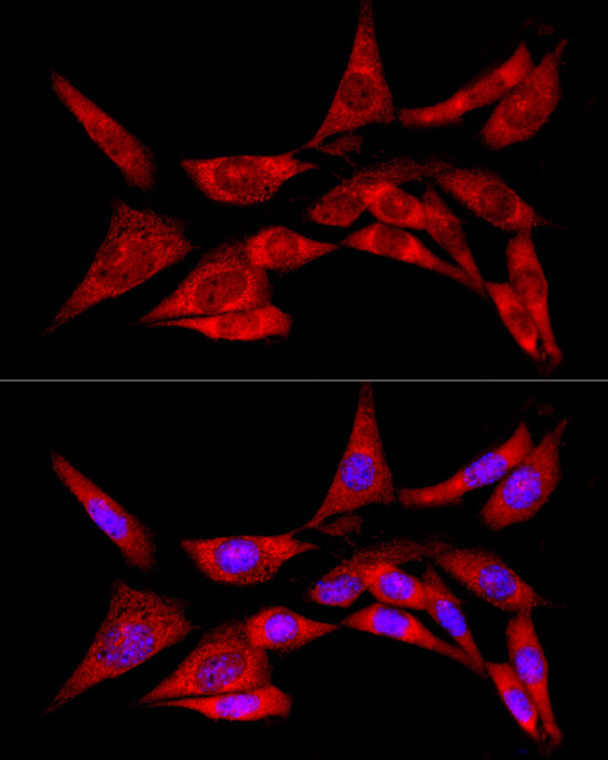| Host: |
Rabbit |
| Applications: |
WB/IF |
| Reactivity: |
Human/Mouse/Rat |
| Note: |
STRICTLY FOR FURTHER SCIENTIFIC RESEARCH USE ONLY (RUO). MUST NOT TO BE USED IN DIAGNOSTIC OR THERAPEUTIC APPLICATIONS. |
| Short Description: |
Rabbit polyclonal antibody anti-CREB3 (1-230) is suitable for use in Western Blot and Immunofluorescence research applications. |
| Clonality: |
Polyclonal |
| Conjugation: |
Unconjugated |
| Isotype: |
IgG |
| Formulation: |
PBS with 0.01% Thimerosal, 50% Glycerol, pH7.3. |
| Purification: |
Affinity purification |
| Dilution Range: |
WB 1:500-1:2000IF/ICC 1:10-1:100 |
| Storage Instruction: |
Store at-20°C for up to 1 year from the date of receipt, and avoid repeat freeze-thaw cycles. |
| Gene Symbol: |
CREB3 |
| Gene ID: |
10488 |
| Uniprot ID: |
CREB3_HUMAN |
| Immunogen Region: |
1-230 |
| Immunogen: |
Recombinant fusion protein containing a sequence corresponding to amino acids 1-230 of human CREB3 (NP_006359.3). |
| Immunogen Sequence: |
MELELDAGDQDLLAFLLEES GDLGTAPDEAVRAPLDWALP LSEVPSDWEVDDLLCSLLSP PASLNILSSSNPCLVHHDHT YSLPRETVSMDLESESCRKE GTQMTPQHMEELAEQEIARL VLTDEEKSLLEKEGLILPET LPLTKTEEQILKRVRRKIRN KRSAQESRRKKKVYVGGLES RVLKYTAQNMELQNKVQLLE EQNLSLLDQLRKLQAMVIEI SNKTSSSSTC |
| Tissue Specificity | Ubiquitously expressed. Expressed in dendritic cells (DC). Weakly expressed in monocytes (at protein level). |
| Post Translational Modifications | First proteolytically cleaved by site-1 protease (S1P) that generates membrane-associated N-terminus and a luminal C-terminus forms. The membrane-associated N-terminus form is further proteolytically processed probably by the site-2 protease (S2P) through a regulated intramembrane proteolysis (RIP), releasing the transcriptional active processed cyclic AMP-responsive element-binding protein 3 form, which is transported to the nucleus. The proteolytic cleavage is strongly induced during dendritic cell (DC) maturation and inhibited by DCSTAMP. That form is rapidly degraded. N-glycosylated. |
| Function | Endoplasmic reticulum (ER)-bound sequence-specific transcription factor that directly binds DNA and activates transcription. Plays a role in the unfolded protein response (UPR), promoting cell survival versus ER stress-induced apoptotic cell death. Also involved in cell proliferation, migration and differentiation, tumor suppression and inflammatory gene expression. Acts as a positive regulator of LKN-1/CCL15-induced chemotaxis signaling of leukocyte cell migration. Associates with chromatin to the HERPUD1 promoter. Also induces transcriptional activation of chemokine receptors. (Microbial infection) Plays a role in human immunodeficiency virus type 1 (HIV-1) virus protein expression. Isoform 1: (Microbial infection) May play a role as a cellular tumor suppressor that is targeted by the hepatitis C virus (HCV) core protein. Isoform 1: (Microbial infection) Plays a role in herpes simplex virus-1 (HSV-1) latent infection and reactivation from latency. Represses the VP16-mediated transactivation of immediate early genes of the HSV-1 virus by sequestering host cell factor-1 HCFC1 in the ER membrane of sensory neurons, thereby preventing the initiation of the replicative cascade leading to latent infection. Isoform 2: Functions as a negative transcriptional regulator in ligand-induced transcriptional activation of the glucocorticoid receptor NR3C1 by recruiting and activating histone deacetylases (HDAC1, HDAC2 and HDAC6). Also decreases the acetylation level of histone H4. Does not promote the chemotactic activity of leukocyte cells. Processed cyclic AMP-responsive element-binding protein 3: This is the transcriptionally active form that translocates to the nucleus and activates unfolded protein response (UPR) target genes during endoplasmic reticulum (ER) stress response. Binds the cAMP response element (CRE) (consensus: 5'-GTGACGTAGAG-3') and C/EBP sequences present in many promoters to activate transcription of the genes. Binds to the unfolded protein response element (UPRE) consensus sequences sites. Binds DNA to the 5'-CCACGA-3'half of ERSE II (5'-ATTGG-N-CCACG-3'). Processed cyclic AMP-responsive element-binding protein 3: (Microbial infection) Activates transcription of genes required for reactivation of the latent HSV-1 virus. It's transcriptional activity is inhibited by CREBZF in a HCFC1-dependent manner, by the viral transactivator protein VP16. Binds DNA to the cAMP response element (CRE) (consensus: 5'-GTGACGTAGAG-3') and C/EBP sequences present in many viral promoters. Processed cyclic AMP-responsive element-binding protein 3: (Microbial infection) It's transcriptional activity is inhibited by CREBZF in a HCFC1-dependent manner, by the viral transactivator HCV core protein. |
| Protein Name | Cyclic Amp-Responsive Element-Binding Protein 3Creb-3Camp-Responsive Element-Binding Protein 3Leucine Zipper ProteinLumanTranscription Factor Lzip-Alpha Cleaved Into - Processed Cyclic Amp-Responsive Element-Binding Protein 3N-Terminal LumanTranscriptionally Active Form |
| Database Links | Reactome: R-HSA-8874211 |
| Cellular Localisation | Isoform 1: Endoplasmic Reticulum MembraneSingle-Pass Type Ii Membrane ProteinGolgi ApparatusColocalizes With Hcfc1 In Neuronal Cell Bodies Of The Trigeminal GangliaColocalizes With Dcstamp In The Er Membrane Of Immature Dendritic Cell (Dc)Colocalizes With CanxCcr1Hcfc1 In The Er MembraneIsoform 1: Cytoplasm(Microbial Infection) Sequestered Into The Cytoplasm By The Hcv Core ProteinIsoform 2: NucleusCytoplasmPredominantly In The NucleusNot Associated With MembranesProcessed Cyclic Amp-Responsive Element-Binding Protein 3: NucleusUpon Rip Activation The Transcriptional Active Processed Cyclic Amp-Responsive Element-Binding Protein 3 Form Translocates Into The NucleusDetected In The Nucleus Upon Dendritic Cell Maturation And Rip ActivationColocalizes With Crebrf In Nuclear FociColocalizes With Crebzf In Promyelocytic Leukemia Protein Nuclear Bodies (Pml-Nb) |
| Alternative Antibody Names | Anti-Cyclic Amp-Responsive Element-Binding Protein 3 antibodyAnti-Creb-3 antibodyAnti-Camp-Responsive Element-Binding Protein 3 antibodyAnti-Leucine Zipper Protein antibodyAnti-Luman antibodyAnti-Transcription Factor Lzip-Alpha Cleaved Into - Processed Cyclic Amp-Responsive Element-Binding Protein 3 antibodyAnti-N-Terminal Luman antibodyAnti-Transcriptionally Active Form antibodyAnti-CREB3 antibodyAnti-LZIP antibody |
Information sourced from Uniprot.org
12 months for antibodies. 6 months for ELISA Kits. Please see website T&Cs for further guidance









